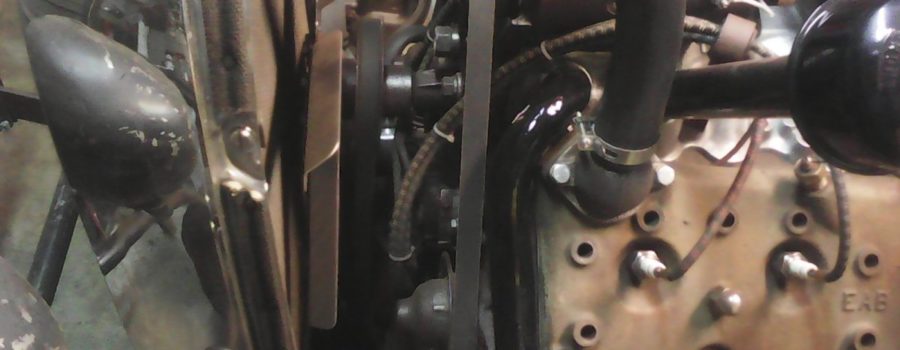The B.B. in the title represents that this is from the archive of the late Bill Bently, who ran a flathead Q&A informational site before he passed away. All threads from this source will be titled using the B.B. identifier on this site. We’re archiving some of the threads, so that his work is not lost or forgotten and so they will continue to educate flathead enthusiasts for years to come.
Rumble Seat (Oct 18 1999 4:37PM cooling systems
Earlier this month I suggested one method to check the coolant for presence of inhibitors. I was pretty brief about it and probably left many questions hanging. I’ll try to correct that now. Remembering our high school physics…. Basically, when two different metals are grounded and are immersed in an acidic solution, a current is produced that will flow ‘in that liquid. This current causes particles of the softer metal to transfer to the harder metal. Which is electrolysis. As can be visualized, this eats the softer metals (aluminum and copper) in our Flathead radiators and heads quickly. As long as there are adequate inhibitors present, the solution is not acidic and current will not be produced. Therefore, all we need to do is to check the solution for voltage to see if the inhibitors are still in existence. Just use a common Volt-Ohm meter (VOM) and set the selector on 2 volts DC. Then position one probe (either one) in the radiator coolant (don’t let it touch the metal tank) and ground the other probe to the radiator. If the meter registers more than 0.5 volts, the inhibitors are insufficient. If 0.5 volts or less, the inhibitors are still good. You can either replace your coolant or simply add new inhibitors that can be purchased from your parts supplier. Hope I’ve not offended any physics persons with my loose interpretations rumble seat
Bill M (Nov 19 1999 2:58PM) RE: Coolant leak
TIM flat heads are known for leaking around head bolts and studs, i have always used copper gaskets, sprayed them with silver paint, a good even coat,let it dry and install, if you have head studs you can use thread sealer on them when you reinstall them, not practical on head bolts because you have remove them when working on engine,but back to basics, have block decked(surfaced) along with heads,follow torque sequence exactly, go around pattern 3 times, ok back to your question, warm engine up re-torque head bolts, if you still have a leak, use a tube of silver seal or copper seal in radiator, run for a week then flush out completely, aluminum seal is also excellent for sealing weeping bolts, this has worked for me over the years, i have raced and driven flat heads for 45 years, using the sealants is the fastest way to stop the problem until you are ready to tear down the engine completely, and they do work
Rumble seat (Nov 19 1999 8:53PM) RE: Coolant leak
Everyone has different sealants and methods. Here’s what I do. I use regular fiber gaskets on engines up to and including 5/16 inch overbore. These come with the rebuild gasket kit. The reinforced edge is right to the edge of the cylinder when bored 5/16 and seals very good. When bored bigger that 5/16, stock gaskets extend into the cylinder. So I have to use special gaskets. I use copper big bore head gaskets. Fel Pro makes a good one at $30-35 each. Big A auto parts also offer them under their part #NGA.3036 and are slightly cheaper. Both work okay for me. I don’t use any sealant on gaskets used with stock cast iron heads. However I do when using aluminum heads. In my opinion, the stock heads and block have about the same coefficient of expansion and contraction and the head gaskets will seal very nicely. However, the aluminum has a much different coefficient of expansion and contraction than the cast block. To me, this means the heads will expand and contract a lot differently than the block. This means the gasket can’t seal both to the block and to the head… something will have to give to permit expansion and contraction of the dissimilar metals. And the head gasket is the weakest link. I want the head to slide along the top of the gasket surface and not tear or damage it. I put a light film of Ultra-blue silicon gasket maker on both sides of the head gasket. The ultra-blue has more silicon than the regular blue gasket maker and permits the head to move around easier without damaging the head gasket. Just a light film… NO lumps. I don’t let the ultra-blue skim. I want to install the head gaskets and heads before the gasket maker sets up. Another thing I do concerns threads. The threads on the studs, cap screws, and blocks of these engines are old and have been used and abused so much that they’ll permit some wobble. This applies uneven torque surrounding the block thread holes and can lead to cracking blocks… especially if you’ve a 3-3/8 bore. I’ve cracked two engines in a row (down a cylinder wall) three years ago because of this wobble as I call it. To help deter this, I don’t run a tap in the holes in the block. These are usually clean enough and I don’t want to remove even the slightest amount of material. I check them to make sure they’re clean enough with a clean cap screw that is oiled. The threads on the studs or cap screws are cleaned on a wire wheel on the bench grinder. I don’t run a thread chaser on these either… again because I don’t want to remove any material. I seldom find a stud or cap screw that won’t screw into the block using just a speed handle. If there is a tight one, then I’ll use a die or tap. As far as weeping around studs/cap screws… All but a few of the bolts go into the block’s water chambers. Therefore they have to be sealed or else they can leak. I put some thread sealant on each stud/cap screw to prevent this. What I use is Fel Pro Gray Thread Sealant. Their part number is GRA50. This stuff also prevents the stud from gluing itself in and allows them to be removed easily. I don’t use cap screws on big bore engines because I think the higher torque needed has a tendency to deform the block more. I use studs (installed at 10 ft/lbs) and torque the head nuts to 50 ft/lbs. Cap screws are torqued to 60-65 ft/lbs. Offy says to torque their heads to 65-70 ft/lbs…. way too much as far as I’m concerned. Torque three times while assembling. Then heat the engine and let cool. Torque twice more. Heat again and let cool. Torque again. Every 6 months I re torque again. Use grade 8 flat washers to keep from digging into the soft aluminum head. I use grade 8 nuts too since most of the stock nuts are pretty sloppy by now (the chrome acorn dress up items slip down flush with the thinner grade 8 nuts too). If you have a leaking stud, I’d be very careful since the stud is probably stuck tight in the block. And with the head on, it’ll be nearly impossible to get it out. Try some aluminum stop leak. If you have cap screws, remove the cap screw and use some sealant and reinstall and torque. It should seal. Hope this answers some of your questions…… rumble seat
Was this article a help? Consider supporting the Flat-Spot by becoming a Premium Member. Members get discounts with well known retailers, a cool membership packet full of goodies and your membership goes toward helping us upkeep and expand on this great archive.











